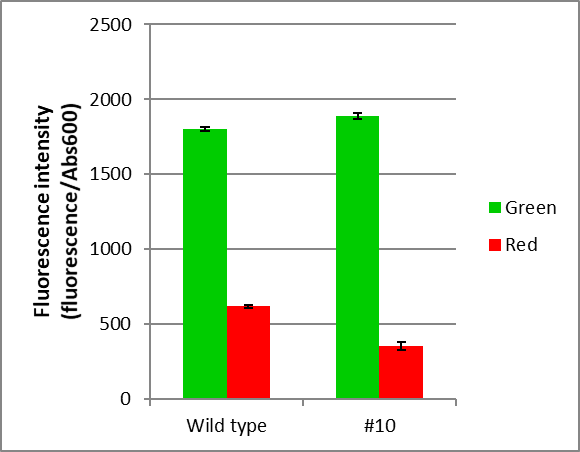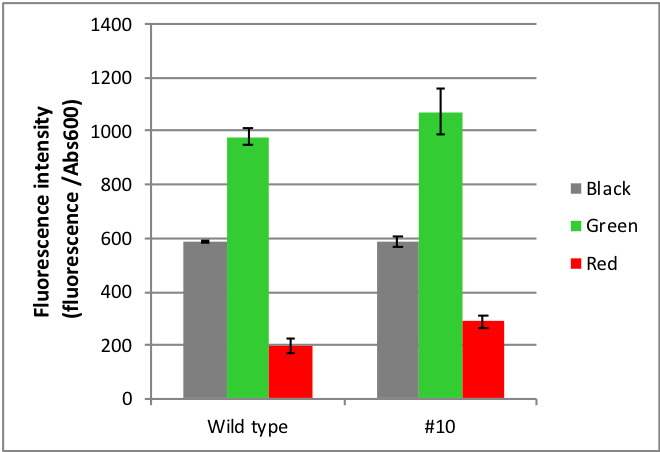Difference between revisions of "Part:BBa K2627002"
ChenKening (Talk | contribs) |
|||
| (5 intermediate revisions by 2 users not shown) | |||
| Line 2: | Line 2: | ||
__NOTOC__ | __NOTOC__ | ||
<partinfo>BBa_K2627002 short</partinfo> | <partinfo>BBa_K2627002 short</partinfo> | ||
| − | + | ===Usage and Biology=== | |
| − | CcaS belongs to | + | <p>CcaS protein belongs to green/red light sensing two-component system. The two-component system consists of the membrane-associated histidine kinase CcaS and its response regulator CcaR. The activating information stored in light is captured by phytochromes in situ. In phytochromes, a bilin-chromophore (in this case phycocyanobilin) binds at a conserved cysteine within an N-terminal GAF (cyclic GMP phosphodiesterase, adenylyl cyclase, FhlA) domain and imparts reversible photoactivation of signaling activity with maximal responses to 535-nm (green) and 672-nm (red) light. Absorption of green light increases the rate of CcaS autophosphorylation, phosphorylation of CcaR by phosphate transferring, and transcription from the promoter of the phycobilisome linker protein cpcG2, while absorption of red light reverses this process. The lower leakiness is reported to be acquired after removing the second putative promoter in cpcG2, which is thought to be constitutive and contributes to leakiness and low dynamic range.</p> |
[[File:T--SDU-China--3410.png|800px|center]] | [[File:T--SDU-China--3410.png|800px|center]] | ||
| + | <p>Part BBa_K2627002 was developed from the original CcaS protein (part BBa_K592001) by removing the two PAS domains, leading to a lower leakage under red light.</p> | ||
<!-- Add more about the biology of this part here | <!-- Add more about the biology of this part here | ||
| − | + | ||
<!-- --> | <!-- --> | ||
| Line 18: | Line 19: | ||
<!-- --> | <!-- --> | ||
==Results== | ==Results== | ||
| − | [[File:T--SDU-China--10.png| | + | ===Characterization of part BBa_K2627002=== |
| − | Figure 1:Characterization of part BBa_K2627002 and BBa_K592001. Part BBa_K2627002 shows a higher expression index under green light condition | + | <p>Part BBa_K2627001 was characterizaed through measuring relative fluorescence intensity, this measurment was taken place in 24-well plates. Cells were cultured in the seed culture medium for 12 hours before inoculated in 24-well plates in three kinds of culture medium. Then fluorescence intensity of CcaS#4 was measured at 9h in comparison with BBa_K592001.<br> |
| + | The following figure shows the relative fluorescence intensity induced by green light and red light.</p> | ||
| + | |||
| + | [[File:T--SDU-China--10.png|600px|center|thumb|<p align="justify">''' | ||
| + | Figure 1. Characterization of part BBa_K2627002 and BBa_K592001 in M9 medium whose carbon source is glucose. Part BBa_K2627002 shows a lower expression index under green light condition and a higher leak index under red light condition. The dynamic ranges of green over red light of different system are: 5.0(Wild type), 2.9(#10).'''</p>]] | ||
| + | |||
| + | [[File:T--SDU-China--102.png|600px|center|thumb|<p align="justify">''' | ||
| + | Figure 2. Characterization of part BBa_K2627002 and BBa_K592001 in M9 medium whose carbon source is glycerol. Part BBa_K2627002 shows a higher expression index under green light condition, a lower leak index under red light condition. The dynamic ranges of green over red light of different system are: 2.8(Wild type), 4.9(#10).'''</p>]] | ||
| + | [[File:T--SDU-China--103.png|600px|center|thumb|<p align="justify">''' | ||
| + | Figure 3. Characterization of part BBa_K2627002 and BBa_K592001 in M9 medium whose nitrogen source is yeast extract. Part BBa_K2627002 shows a higher expression index under green light condition, a similar leak index under dark condition and a higher leak index under red light condition. The dynamic ranges of green over red light of different system are: 5.0(Wild type), 6.2(#10).'''</p>]] | ||
| + | |||
| + | |||
| + | ==XHD-Wuhan-B-China== | ||
Latest revision as of 09:25, 1 October 2021
Advanced CcaS with PAS domain knocked out
Usage and Biology
CcaS protein belongs to green/red light sensing two-component system. The two-component system consists of the membrane-associated histidine kinase CcaS and its response regulator CcaR. The activating information stored in light is captured by phytochromes in situ. In phytochromes, a bilin-chromophore (in this case phycocyanobilin) binds at a conserved cysteine within an N-terminal GAF (cyclic GMP phosphodiesterase, adenylyl cyclase, FhlA) domain and imparts reversible photoactivation of signaling activity with maximal responses to 535-nm (green) and 672-nm (red) light. Absorption of green light increases the rate of CcaS autophosphorylation, phosphorylation of CcaR by phosphate transferring, and transcription from the promoter of the phycobilisome linker protein cpcG2, while absorption of red light reverses this process. The lower leakiness is reported to be acquired after removing the second putative promoter in cpcG2, which is thought to be constitutive and contributes to leakiness and low dynamic range.
Part BBa_K2627002 was developed from the original CcaS protein (part BBa_K592001) by removing the two PAS domains, leading to a lower leakage under red light.
Sequence and Features
- 10COMPATIBLE WITH RFC[10]
- 12INCOMPATIBLE WITH RFC[12]Illegal NheI site found at 606
Illegal NheI site found at 663 - 21INCOMPATIBLE WITH RFC[21]Illegal XhoI site found at 1379
- 23COMPATIBLE WITH RFC[23]
- 25COMPATIBLE WITH RFC[25]
- 1000COMPATIBLE WITH RFC[1000]
Results
Characterization of part BBa_K2627002
Part BBa_K2627001 was characterizaed through measuring relative fluorescence intensity, this measurment was taken place in 24-well plates. Cells were cultured in the seed culture medium for 12 hours before inoculated in 24-well plates in three kinds of culture medium. Then fluorescence intensity of CcaS#4 was measured at 9h in comparison with BBa_K592001.
The following figure shows the relative fluorescence intensity induced by green light and red light.

Figure 1. Characterization of part BBa_K2627002 and BBa_K592001 in M9 medium whose carbon source is glucose. Part BBa_K2627002 shows a lower expression index under green light condition and a higher leak index under red light condition. The dynamic ranges of green over red light of different system are: 5.0(Wild type), 2.9(#10).

Figure 2. Characterization of part BBa_K2627002 and BBa_K592001 in M9 medium whose carbon source is glycerol. Part BBa_K2627002 shows a higher expression index under green light condition, a lower leak index under red light condition. The dynamic ranges of green over red light of different system are: 2.8(Wild type), 4.9(#10).

Figure 3. Characterization of part BBa_K2627002 and BBa_K592001 in M9 medium whose nitrogen source is yeast extract. Part BBa_K2627002 shows a higher expression index under green light condition, a similar leak index under dark condition and a higher leak index under red light condition. The dynamic ranges of green over red light of different system are: 5.0(Wild type), 6.2(#10).

